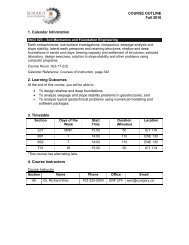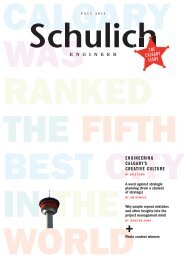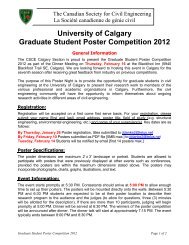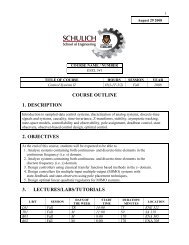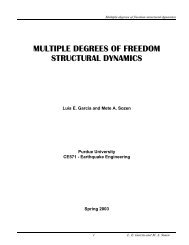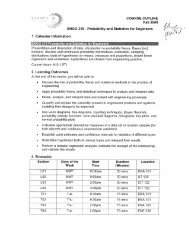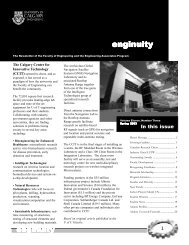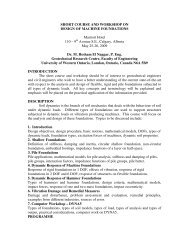high performance - The Schulich School of Engineering - University ...
high performance - The Schulich School of Engineering - University ...
high performance - The Schulich School of Engineering - University ...
- No tags were found...
Create successful ePaper yourself
Turn your PDF publications into a flip-book with our unique Google optimized e-Paper software.
Ductal was used in the construction <strong>of</strong> theShawnessy C-train station in Calgary, including 24ultra-thin canopies supported on single columns.Photo courtesy Lafarge North AmericaWhat better way to develop stronger materials thanby putting them to the test under rigorous, real-lifeconditions. Blowing rain, load fluctuations, salt waterspray, freezing, thawing and everything in between canbe programmed to happen inside a massive stainlesssteel environmental testing chamber at the <strong>Schulich</strong><strong>School</strong> <strong>of</strong> <strong>Engineering</strong>. At 10 metres long, it is thelargest facility <strong>of</strong> its kind in North America. <strong>The</strong> airinside can go from room temperature down to minus68°C all the way up to 85°C in just four hours. It weighsmore than 11 tonnes, and that’s without all the tanks,pumps and electronics. Researchers can simulatepractically any weather condition and humidity level.“<strong>The</strong> chamber allows us to test different types and sizes<strong>of</strong> large-scale structural members and materials suchas concrete, masonry, steel, timber and composites,”explains Raafat El-Hacha, project leader and structuralengineering pr<strong>of</strong>essor. “We can evaluate the effects<strong>of</strong> the environment and loading factors on thedeterioration <strong>of</strong> civil infrastructure by simulatingsevere environmental exposure conditions.”Before and after: steel rebar is badly corroded after twoweeks in the environmental testing chamber.Photo by David Moll<strong>The</strong> harsh Canadian climate regularly pummelsbridges, roads and buildings but the damage may notbe apparent for years. El-Hacha can see first-handwhat happens to materials when they are subjectedto extreme conditions over and over again. A length<strong>of</strong> steel rebar emerged badly corroded after twoweeks in the chamber; the bottom half <strong>of</strong> a masonryblock crumbled to dust within a month. This is whatmakes the environmental testing chamber so exciting:researchers can essentially speed up time. >>



